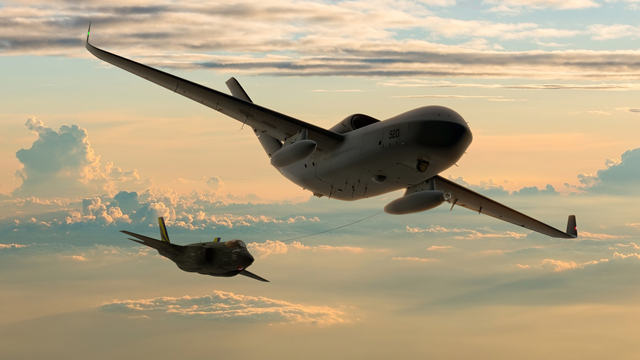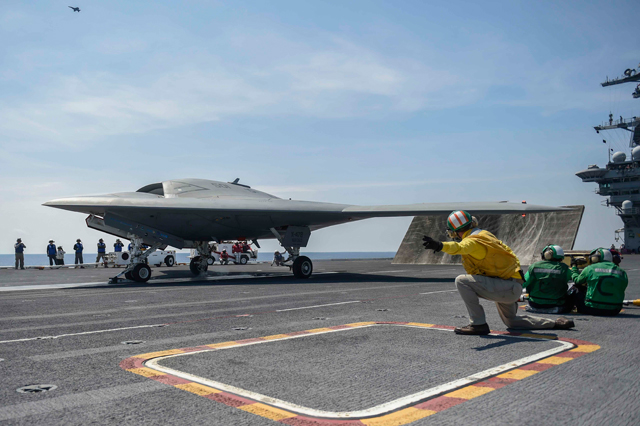A "Group 5" unmanned air system holds a special place in the US military's jargon. As the largest and most capable UAS in the inventory, the Group 5 fleet forms an exclusive club. For now, only three aircraft types in development or production are included: General Atomics Aeronautical Systems' MQ-9 Reaper, plus Northrop Grumman's RQ-4 Global Hawk and MQ-4C Triton.
By design, these large and long-endurance aircraft operate in secluded airspace as far as possible from manned aircraft, each performing their singular missions in safe isolation.
Within the next decade, the US Navy's next big aircraft contract intends to change that dynamic, thrusting a new Group 5 UAS into intimate proximity with manned aircraft in the air and on the deck of an aircraft carrier.
The future MQ-25 Stingray's primary mission has devolved from a stealthy, carrier-based, unmanned bomber to an aerial refuelling system, but its fundamental contribution to the Department of Defense's portfolio of unmanned capabilities has never changed.

General Atomics' design would extend range of combat assets like F-35C
General Atomics Aeronautical Systems
The DoD already has large unmanned aircraft that can launch weapons at targets. It also has Group 5 UAS that can collect intelligence during long-endurance flights. What it still lacks is a large UAS designed from the outset to operate within metres or less of large manned aircraft.
The USN's uneasiness with that prospect has been apparent over the programme's long and unusually tortuous history. At the turn of the century, US naval aviators began pursuing an unmanned combat air vehicle based on an aircraft carrier. Hopes were rekindled about the prospect of reviving the deep strike capability once promised by the McDonnell Douglas/General Dynamics A-12 Avenger, a stealthy, manned bomber cancelled in 1991. The navy’s concept was folded into the US Defense Advanced Research Project Agency (DARPA's) joint unmanned combat air systems (J-UCAS) programme. DARPA planned to field the first unmanned bomber by 2008, but the programme lost funding support after 2004 and disappeared in 2006.
The USN moved forward on its own in 2008, awarding a contract to Northrop to develop the X-47 as an unmanned combat air system-demonstrator (UCAS-D), showing it was possible to safely operate a tailless aircraft designed with a stealthy planform from a carrier deck.
SLOW PROGRESS
Although the demonstration was deemed successful, navy officials seemed paralysed about how to move beyond it. Internal frustrations over the deadlock spilled into public view in 2010, when then-chief of naval operations Gary Roughead yelled back at a questioner at the AUVSI convention about whether the USN's plan to field such an aircraft by 2018 was moving too quickly. “For me, [the schedule is] too damn slow,” Roughead said. “Seriously, we’ve got to have a sense of urgency about getting these things out there.”
Even as Roughead called for urgency, the programme's mission was facing an internal make-over. Rather than fielding a small, penetrating bomber, the USN re-assigned the new aircraft to collecting aerial intelligence on long, 14h missions. The so-called unmanned carrier-launched surveillance and strike (UCLASS) aircraft would still carry weapons, but would lack the stealthy features required to operate deep inside defended airspace.
That approach only seemed to inflame the controversy surrounding the programme, however, with senior US lawmakers, including Sen John McCain, pushing the USN to return to the bomber concept and the Obama administration reportedly pushing for something in between a bomber and the USN's focus on intelligence gathering.
The impasse dragged on until January 2016. In that month, Robert Work, then-deputy secretary of defense and previously an outspoken advocate for the bomber mission, intervened. After concluding that it would take too long to field an unmanned bomber with the same level of stealthy complexity as the Lockheed Martin F-35C, Work ordered the USN to accelerate procurement of the latter, according to an interview he gave to the Aerospace America journal in April the same year.

X-47B demonstrator served as initial proof of concept
US Navy
With the USN's aircraft carriers now relying on the 600nm (1,110km) range of the F-35C for decades to come, Work also ordered the service to convert UCLASS into a carrier-based air refuelling system (CBARS), allowing its F-35Cs and Boeing F/A-18E/F Super Hornets to fly longer missions.
Four contractors spent another year converting their designs from UCLASS into CBARS, but not without some difficulty. Lockheed attempted to modify its surveillance and strike UAS into a tanker, but ultimately gave up and started over with a clean sheet of paper, says Rob Weiss, vice-president in charge of its Skunk Works unit. Northrop also converted its flying wing design into a tanker, but, in the end, decided to drop out of the competition. The UCLASS designs by Boeing Phantom Works and General Atomics had begun with a wing-body-tail configuration, so required fewer changes.
After responding to the USN's request for proposals, all three bidding companies are waiting for the scheduled contract award by the end of this year. The total value of the programme is not known, but the USN has earmarked about $2.2 billion in the budget through fiscal year 2022 to spend on the air system component of the MQ-25 programme. The milestone for declaring initial operational capability of the MQ-25 is set for FY2026: more than seven years after contract award.
UNORTHODOX APPROACH
The handling of the "air system" as merely a component of the programme betrays one of the most unique features of the USN's acquisition strategy for the MQ-25.
For the first time in an aircraft development programme, the navy will assume the role as the lead systems integrator. This means that the service – and not the air system contractor – will develop the MQ-25's carrier-based cockpit, which is designated as the MD-5, as part of the control station and connectivity segment. The USN also is responsible for delivering the Carrier Vessel, Nuclear segment, which includes adapting its ships to accommodate the MQ-25 and the MD-5, such as modifying the joint precision approach landing system and the airborne launch and recovery equipment systems.
Such an arrangement produces some awkward moments. When asked for details about the concept of operations for the aerial refuelling system, the contractors can only shrug and say the lead system integrator has not shared it yet.
But it also narrows the contractor's focus on the air system component only. Although details of the in-flight choreography of aerial refuelling are not known, the contractors are responsible for designing a system that manoeuvres the aircraft around the carrier deck, obeying commands from a yellow-shirted deck handler as any manned aircraft would.
The UCAS-D activity allowed Northrop to take the first crack at inventing such a system. The X-47B was controlled on deck by an additional crewman who stood beside the yellow-shirted deck-handler. The additional crewman wore a battery-powered controller on his right hand, which was connected by radio frequency data link to the vehicle. As the yellow-shirt commanded a manoeuvre, the crewman used the controller to move the aircraft right, left and forward.
Boeing is keeping its approach to deck handling operations a competitive secret, but General Atomics and Lockheed have provided full details. Strikingly, neither company adopts Northrop's pioneering approach on the X-47B, but has adopted two very different approaches.
In General Atomics' system, there is no need for adding a dedicated crewmember solely for deck handling. Instead of using a person to interpret the deck handler's commands and relay them to the aircraft, the company has developed a "smart wand". The gestures used by the deck handler are transmitted by the wand to the vehicle, which responds as if a pilot was on board.
Lockheed's system requires adding a crewmember simply for deck handling, but offers a certain degree of simplicity. A camera is embedded in the front of the aircraft. The video captures the commands by the deck handler, then transmits the feed in real time to an operator below decks.
Source: Flight International



















